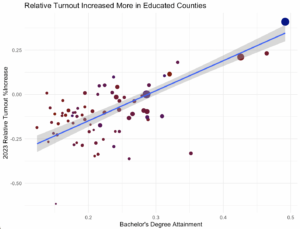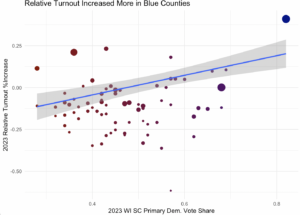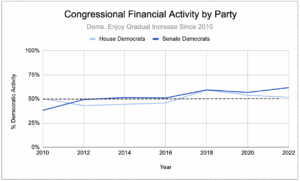For the past few years, national Democrats have publicly bemoaned how increased education polarization has given Republicans a significant structural advantage in some governing bodies. As white voters without a bachelor’s degree in the Rust Belt shifted to the right, Republicans enjoyed a substantial positive bias in the Electoral College in 2016 and 2020 that seems likely to continue in the near future. And as white voters without a bachelor’s degree are vastly over-indexed by the structure of the United States Senate, Republicans enjoy a dominant positive bias in the US Senate.
Education Polarization has undeniably had a net-negative impact on structural advantages for Democrats. Media attention has (correctly) focused on how the past decade of realignment has led to the Democratic Party suffering from substantial structural disadvantages in two of the most important portions of the US Federal Government: the US Senate and the Executive Branch. And for a while, it has been hard to figure out any redeeming qualities of recent realignment for the Democratic Party.
As political observers prepare for an exceptionally important Wisconsin State Supreme Court Election on April 4th, some positive consequences (for partisan Democrats, at least) of Education Polarization are beginning to appear. Republicans currently hold a 4-3 majority on the court, but this election may be the most important of 2023 as liberals look to flip the judicial body away from conservative control. The general election is a competition between liberal Milwaukee County Judge Janet Protasiewicz and conservative former Justice Dan Kelly. This election has several far-reaching consequences as the state Supreme Court is set to weigh in on many important decisions, including abortion access, voting and election laws, and state and federal legislative district boundaries. While education polarization limited Democratic progress on various policy objectives during the 2010s, these newfound structural benefits could help Wisconsin Democrats achieve their progressive objectives.
A Triple Threat: Three Important Ways Education Polarization is Helping Democrats
1. Democrats Are Well on Their Way to Positive Structural Bias in the US House
Last year, I wrote about how Democrats unexpectedly held a structural advantage in the US House in the 2022 Midterms. This idea has started to receive increased coverage in mainstream media and is extremely significant. For the past decade, the US House has been notably biased in favor of the GOP. But as Education Polarization continues, Democratic gains in the suburbs seem extremely likely to lead the party to a small structural advantage in the House for the rest of the decade.
2. Democrats Now Have Substantial Advantages in Low-Turnout Elections
Educational Polarization has substantially changed the composition of the voter base of both parties. Since more educated Americans tend to be more politically engaged and active, Democrats benefit from their increasingly educated voter base in off-cycle elections. Democrats won consecutive pivotal Senate Runoff elections in Georgia, and liberals seem poised to win another important low-turnout election on April 4th.
In the lead-up to the April 4th Wisconsin Supreme Court Election, analysts will focus on results from the February 21st Primary. In the February 21st Primary election, voters chose from four candidates on the same ballot (two conservatives and two liberals), with the first and second-place finishers advancing to the general election. While President Joe Biden only won Wisconsin by a ~0.6% margin in 2020, the two liberal judges won the state by a dominant ~7.8% margin in the 2023 primary.
Turnout in the February 2023 Supreme Court primary was substantially lower than in the 2020 Presidential election, but this difference varied substantially by county. For example, extremely educated and Democratic Dane County (Madison) composed 10.5% of Wisconsin’s statewide vote in 2020 and 14.7% of the statewide vote in 2024. This change is a ~41% increase in Dane relative to statewide turnout. The figure below compares county bachelor’s attainment to this change in relative turnout between the November 2020 and February 2023 elections and displays a robust positive correlation between the two statistics. It confirms the hypothesis that more educated Americans are more politically active, voting disproportionately often in lower-turnout American elections.

Since more educated voters tend to back the Democratic Party, the figure below compares county partisan lean to change in relative turnout, confirming that Democrats enjoyed a substantial turnout advantage in the February 2023 WI SC Primary Election.

Countywide turnout shifts alone explain ~44% of the 7.2% increase in the Democratic margin in Wisconsin from November 2020 to February 2023. If the relative countywide turnout is the same on April 4th as February 21st, Kelly must outrun Trump by at least ~4 points in each county to defeat Protasiewicz. This educated-voter turnout advantage means Dan Kelly has a mountain to climb—to achieve victory, he must outperform Trump in voter persuasion.
3. Democrats Are Beginning to Benefit From Citizens United
Democrats have long opposed The US Supreme Court’s decision in Citizens United vs. FEC, which allowed effectively unlimited corporate spending in American electoral politics. Citizens United also opened the door for massive SuperPAC spending, which increased their electoral expenditures by more than 100x between 2010 and 2018. While most political observers accept the conventional wisdom that the Citizens United decision helps Republicans (and a variety of studies by political scientists indicated that this was, initially, the case), education polarization has turned this phenomenon on its head. While Congressional Democrats have historically been outspent by Republican candidates, white-collar partisan realignment has led Democrats to hold a monetary advantage in recent election cycles.

Protasiewicz holds a substantial spending edge over Kelly, further compounding her structural advantage in the April 4th general election. The liberal judge has amassed a massive financial advantage, spending $9.3 million to Kelly’s $70k in the general election through March 17th. While multiple conservative outside groups have recently placed multi-million dollar ad buys backing Kelly, total liberal spending has still outpaced conservative spending by a factor of 1.7:1 through early March.
What’s Next?
If education polarization continues, Democrats are in store to benefit more than Republicans from this point on. The long-term durability of Republican structural advantages in the Senate and Electoral College depends on whether a variety of battleground states are to the left or right of the nation as a whole. Most battleground states (including Arizona, Georgia, Pennsylvania, and Wisconsin) boast bachelor’s attainment rates comparable to the nation as a whole, meaning these structural biases should not be directly affected by further realignment. Contrarily, Democrats should be optimistic that their structural advantages will continue to develop as education polarization intensifies. Democrats will see their turnout advantage in lower salience elections grow as these educated voters turn out at higher rates and more universally vote blue. And as white-collar America continues to abandon the Republican Party, Democrats will only see their fundraising edge grow. Education polarization did its part to empower Republicans in the 2010s, but its effects will be far more moderated in the 2020s.
Resources: What is Education Polarization?
Below is a list of resources about Education Polarization:
New York Times: How Educational Differences Are Widening America’s Political Rift
Politico: Elections 2022: The educational divide that helps explain the midterms
Slow Boring: Education Polarization is only growing